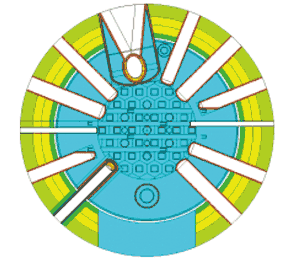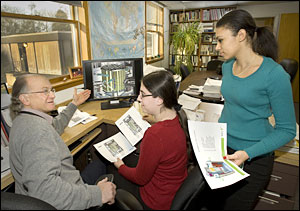
Nuclear Systems & Structural Analysis Group
The mission of the group is to provide nuclear and engineering analysis support in matters related to nuclear reactor design and safety, non-reactor nuclear facilities, nuclear fuel cycles, and proliferation resistance and physical protection of nuclear energy systems.
The staff in the Nuclear Systems & Structural Analysis Group are experts in neutronics, thermal-hydraulics and structural and seismic engineering. They conduct research and development related to nuclear technologies (reactors and accelerator-driven systems), fuel cycle design, and advanced modeling techniques for reactor simulation and energy systems. This expertise is combined with the use of state-of-the-art, complex computer tools to analyze issues of interest to our client base; primarily the Nuclear Regulatory Commission (NRC), Department of Energy (DOE), National Nuclear Security Administration (NNSA) and National Institute of Standards and Technology (NIST).
Nuclear Systems Analysis
The reactor expertise of the group includes power reactors that are currently in operation (light and heavy water cooled reactors) as well as those being proposed for the future (integral light water (small modular reactor), liquid metal, molten salt and gas cooled reactors) and core design including current designs and those proposed with new fuels and cladding material. The group is knowledgeable about research, test, and isotope production reactors, spent fuel pools, critical facilities and hybrid accelerator-critical facilities.
In addition, the group has extensive experience in proliferation risk analysis, evaluating reactor systems and fuel cycle options. The group supports DOE-NE in the evaluation of advanced nuclear systems (reactors and accelerator-driven-systems (ADS)) and fuel cycles, including impacts on performance and safety, proliferation/safeguards, and the role of nuclear systems in the context of competing energy options using the BNL developed MARKAL code. Recent focus:
- Assessing the impact on reactor performance and safety characteristics of Accident Tolerant Fuel (ATF) concepts in commercial LWRs. Work with other national labs, EPRI/NEI, universities with focus on the three main industry ATF concepts, and future advanced fuels and claddings for commercial LWRs.
- Evaluation of performance claims of proposed advanced reactor concepts from industry/international proponents to inform DOE-HQ; transition studies to fuel cycles identified as “most promising relative to current once-through” in multi-year/multi-laboratory Evaluation & Screening of Nuclear Fuel Cycles study; MARKAL market-based analyses of nuclear relative to competing energy systems.
The group’s work in reactor safety and regulatory requirements continues a decades-old tradition of providing in-depth support to the U.S. Nuclear Regulatory Commission (NRC) to ensure that nuclear power plants and research and test reactors operate safely and reliably. The work has included both engineering support using computer tools, and the review of documents submitted to satisfy regulatory requirements. The results of this work have contributed to the development of NRC regulatory guidelines, licensing activities, and operating plant safety. Recent activity:
- Identifying phenomena important to model to facilitate the simulation of steady state and transient neutronic and thermal-hydraulic behavior in molten salt and liquid metal reactors. For the former, the work involved organizing a panel of experts from inside and outside the NRC to provide input via the PIRT (Phenomena Identification and Ranking Table) methodology.
- Drafting the Regulatory Basis Document to support the NRC rulemaking for Emergency Preparedness for Small Modular Rectors and Other New Technologies.
Structural Analysis
Structural analysis experts in the group conduct state-of-the-art research and develop applied programs to evaluate the safety of complex structures and structural components when subjected to severe operational and environmental loads, including earthquakes. Structural analysis efforts include evaluating the response of structures to seismic and impact loading events and the effects of aging degradation on the performance of plant structures. Some major research activities are:
- Conducting research on seismic and structural issues which contribute to the development of regulatory requirements and guidance for ensuring the safety of critical nuclear power plant structures.
- Performing seismic soil-structure-interaction analyses to evaluate the adequacy/limitations of the SASSI computer code for deeply embedded structures such as those being proposed for small modular reactors (SMRs).
- Evaluating industry standards for the analysis and design of safety-related structures to develop the technical basis for their applicability to nuclear power plant designs.
Projects
Examples of research projects and analytical studies include:

Planar view of NIST research reactor at core midplane
Modeling of a boiling water reactor with the TRACE/PARCS coupled thermal-hydraulic/neutronic codes to determine reactor response to hypothetical anticipated transients without reactor trip;
Modeling of the NIST research reactor with the stochastic MCNPX code in order to determine the composition of fuel during an equilbrium cycle; and
Modeling of a pressurized water reactor fuel assembly with the lattice physics code TRITON and the Monte Carlo code SERPENT, and using the core simulator PARCS, to understand reactor behavior with fuel consisting of grains of uranium within SiC in a graphite compact
Using a TRACE PWR model to evaluate the core performance of different accident tolerant fuel designs (various fuel/cladding combinations) under accident conditions.
Developed PRCALC, a Markov-based model for evaluating proliferation and physical protection risk. The model has been applied to evaluate threats against nuclear energy systems and fuel cycle facilities.
Performing dynamic fluid structure interaction analyses for seismic loadings to study the adequacy of modeling techniques when using a computer-based finite element code.
Reviewing the analysis and design of advanced nuclear power plant designs to ensure the safety of their critical structures and structural components.
Collaborating with Japan researchers on addressing significant seismic issues such as 3-D finite element modeling of plant structures and their foundation and fragility of plant structures and components.
Relationships
The group maintains ties with universities and research and regulatory technical support organizations in other countries. Student interns are frequently working with staff in the group. Staff give lectures at universities and are encouraged to go to technical conferences and be committee members in professional societies.

Group Leader
There are no people to show.
Group Contributors
-

Arantxa Cuadra
(631) 344-2352, acuadra@bnl.gov




